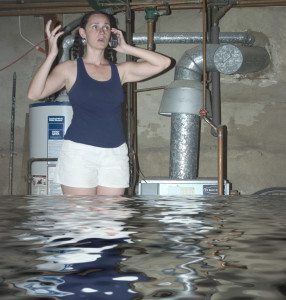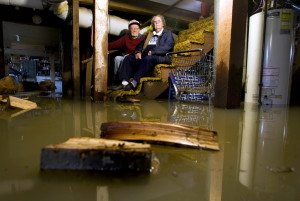— We take our content seriously. This article was written by a real person at BREL.
 Toronto has experienced some fairly significant rainfalls and floods in the last few years. So, what should you do if your basement is flooded?
Toronto has experienced some fairly significant rainfalls and floods in the last few years. So, what should you do if your basement is flooded?
What to Do If Your Basement Is Flooded
1. Above all else, stay safe. There are reports of sewage back-ups, and you don’t want to be wading in raw sewage, let alone the dangers presented by electrical or gas problems. If you’re in trouble, call 911.
2. Call your insurance company. Take photos, keep receipts and hope that you have sewer backup or flood coverage. Your insurance company should be able to recommend who you should call.
3. If water is backing up from the basement drains, don’t flush your toilet or run any water, the dishwasher or washing machine. That’ll only make matters worse.
4. Move electronic equipment or anything valuable to higher levels, including documents.
 5. Keep your kids and pets out of the basement. I hope you didn’t actually need this tip, and everyone is already in a safe and dry room.
5. Keep your kids and pets out of the basement. I hope you didn’t actually need this tip, and everyone is already in a safe and dry room.
6. If you need to call in flood relief professionals, consider calling New Canadians Plumbing. They have 24-hour emergency service and are awesome in an emergency. If you have any recommendations for professional help in dealing with your flooded basement, please leave them in the comments below.
Tips for Cleaning Your Flooded Basement
…from the City of Toronto website:
- Consider hiring a professional cleaning company familiar with cleaning sewage-contaminated basements.
- Keep children and pets out of the affected area until cleanup has been completed.
- Dress appropriately – wear overalls, gloves, protective eyeglasses, rubber boots and a mask.
- Open windows to let fresh air in.
- Stay away from electrical equipment. Have a qualified electrician assess the situation if you are uncertain of potential electrical hazards.
- If you can, shut off the electrical power. (Note: remember this would affect the operation of a sump pump or sewage ejector).
- Water could extinguish a pilot light on a gas appliance. If you detect gas, leave the house immediately and contact the gas company.
- Minor debris can be put out for regular garbage pick-up (See your Garbage and Recycling Collection Calendar for information).
- Discard all contaminated items that cannot be washed and disinfected, (such as mattresses, carpeting, carpet padding, rugs, upholstered furniture, cosmetics, plush toys, baby toys, pillows, foam-rubber items, books, wall coverings, and most paper products).
- Wash all surfaces with hot water and liquid detergent, rinse, thoroughly dry, and ventilate the area. If necessary, use a dehumidifier and fans.
- Sanitize walls and floors using a household bleach solution (mix 1 cup bleach with 5 gallons of water). Never mix bleach with ammonia or other cleaning products.
- Remove and discard drywall and insulation that has been contaminated with sewage or flood waters.
- Wash all clothes worn during the cleanup in hot water (check manufacturer’s washing instructions) and detergent. These clothes should be washed separately from uncontaminated clothes and linens.
- Throw out canned foods, home-prepared food in jars, meats and dairy products and any packaged foods that may have been affected by the floodwaters – check for damaged packaging, leaks, and corrosion at seams and joints of cans.
- If your freezer’s power is off, move the frozen food to another freezer or throw it out if you can’t keep it frozen.
- If in doubt, throw it out. Do not consume potentially contaminated food. For more information, contact Toronto Public Health by calling 311 or visit Toronto Public Health.
